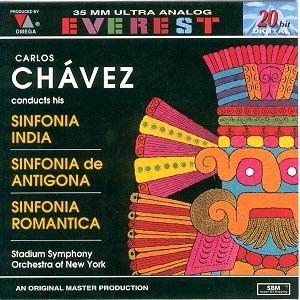CARLOS CHAVEZ (1899-1978)
Symphony No. 1 Sinfonia de Antigona (1932)
[10.50]
Symphony No. 2 Sinfonia India (1935-36)
[11.08]
Symphony No. 4 Sinfonia Romantica (1953)
[21.29]
 Stadium SO of New York/Carlos
Chavez rec 1959
Stadium SO of New York/Carlos
Chavez rec 1959
 EVEREST EVC 9041
[43.47]
EVEREST EVC 9041
[43.47]
AmazonUS

These recordings are significant documents in 20th century music. The composer
conducts his own music but how well does these hold up as enjoyable musical
events?
Chavez was born near Mexico City. In 1926-28 he spent time in New York meeting
both Copland and Varèse. The influences of both can be discerned in
Sinfonia India especially Copland. The 'traffic' was duplex with Copland's
El Salon Mexico inspired by the North American's stay with Chavez
in 1932. The Chavez is uproarious and spangled with strange percussion effects
drawn from Indian drums, water gourd, rasps, rattle and cymbals on top of
the usual orchestral complement.
The first two symphonies are each about as long as a standard concert overture
- circa 10 minutes. Antigona is more tonally exploratory than
India. Surely this is the influence of Varèse and Schoenberg.
The themes are modal and the insistent use of the harp, defiantly up-rearing
banks of string music and the gaunt and tough brass make this an uncomfortable
listen. The work plays out to the antique strains of the plucked harp and
a long held note.
The Romantica is not to be equated with Hanson's Romantic
Symphony. It was commissioned by the Louisville Orchestra and conducted,
at its premiere, by the composer. It marries up some uncompromising dissonances
with a lapping lyrical theme in the first movement,
The orchestra is the New York PO playing under the name it used for summer
seasons at the Lewisohn Stadium, New York.
Recording quality is pretty good though not as refined as the Vaughan Williams
9 or Sibelius Violin Concerto discs.
Starred for the India and Romantica tracks. The Romantica
is a tougher nut to crack with its appealing moments set in a sea of
dissonance.
Rob Barnett


